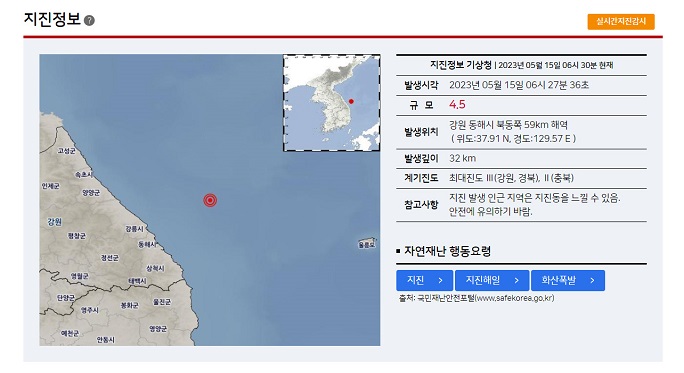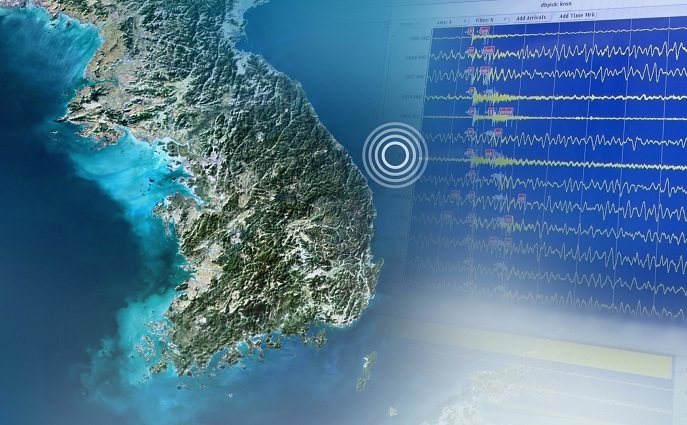
This image, released by the Korea Meteorological Administration on May 15, 2023, shows the location of a 4.5 magnitude earthquake that struck off Donghae in eastern South Korea.
SEOUL, May 15 (Korea Bizwire) — An unusual rash of earthquakes off the northeastern coast in recent months has sparked concerns among the public, with experts not ruling out the possibility of a larger seismic event hitting the region.
Early Monday, a 4.5 magnitude earthquake occurred in waters about 59 kilometers northeast of the eastern coastal city of Donghae, 182 kilometers east of Seoul, according to the Korea Meteorological Administration (KMA).
There have been no reports of damage.
The earthquake is the largest to hit the Korean Peninsula and surrounding waters since Dec. 14, 2021, when a 4.9 magnitude tremor shook off the southern coast of Jeju Island.
The Korean Peninsula has experienced 28 temblors measuring 4.5 magnitude or higher since 1978, when the government began collating seismic data.
A total of 36 minor earthquakes have been reported in the waters off Donghae since March 23, raising concerns they may be precursors of a more powerful tremor to come.
The KMA said the earthquakes seem to have happened on a reverse fault in the area.
A reverse fault is a type of fault where the rock located above the fault plane moves upward relative to the rock below the fault plane.
This occurs as a result of compressional forces that push the rock on one side of the fault up and over the rock on the other side.
“Reverse faults have been detected around the area where the earthquake occurred through oceanographic surveys in the past,” said Cho Chang-soo, director of the Earthquake Research Center at the Korea Institute of Geoscience and Mineral Resources.
He said the earthquake seems to be similar in type to a 4.3 magnitude earthquake that struck 54 kilometers northeast of Donghae on April 19, 2019.
“It would be best if the seismic activities stopped as in the past, but there is a possibility that they could develop into a larger earthquake, so we have to keep closely monitoring,” he said.
The latest earthquakes are believed to be located north of the Hupo Fault or Ulleung Fault, two large faults on the seabed of the East Sea.
“This earthquake is located on the northern extension of the Ulleung Fault. Recent earthquakes are occurring across the fault, which runs parallel to the coastline,” Hong Tae-kyung, a professor at Yonsei University, said.
But little is known about the fault structure in the area, which makes it difficult to project whether there will be more quakes in the future.
“Since the magnitude 4.5 earthquake occurred, we presume there is fault activity. But there are no known faults in the area,” Park Sun-cheon, head of the seismic and volcanic analysis division at the KMA, said.
He said the fault believed to be responsible for the earthquakes may not be large.
It is also possible that either the fault is an extension of a larger one or a larger fault has moved slightly, causing small earthquakes compared with its size, he added.

Officials of the eastern city of Samcheok hold a disaster response meeting at the city hall on May 15, 2023, after a 4.5 magnitude earthquake struck waters off a nearby city of Donghae, in this photo provided by the Samcheok city government.
The strongest earthquake recorded in the East Sea since 1978 was a magnitude 5.2 one that struck off Uljin County on May 29, 2004.
However, data from foreign countries spanning from 1900 to 1978 suggest the East Sea has experienced quakes with magnitudes greater than 6, according to Hong.
“Whether there will be more earthquakes in the future depends on the condition of the fault, which is presently challenging to determine due to a lack of information,” Hong said.
South Korea, considered relatively safe from earthquake dangers, has not invested sufficiently in seismic research, according to experts.
In 2009, the fire and disaster agency conducted a survey of active faults of the Korea Peninsula, but the result was evaluated to fall short of providing adequate information.
After the nation’s largest earthquake on record measuring 5.8 magnitude rattled the southeastern city of Gyeongju in 2016, the country launched a new seismology survey in 2017.
The project is scheduled to be conducted in four phases until 2036, and the result of the first phase covering the southeastern part of the peninsula has recently been unveiled.
(Yonhap)







